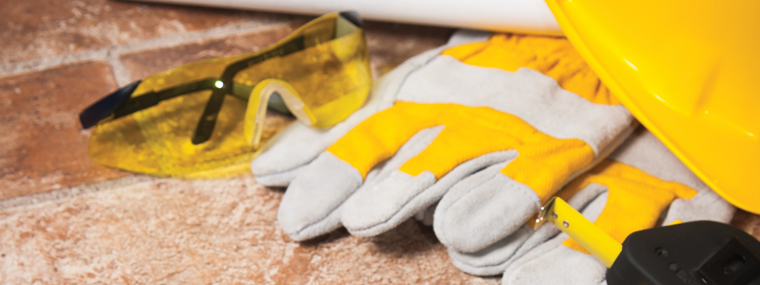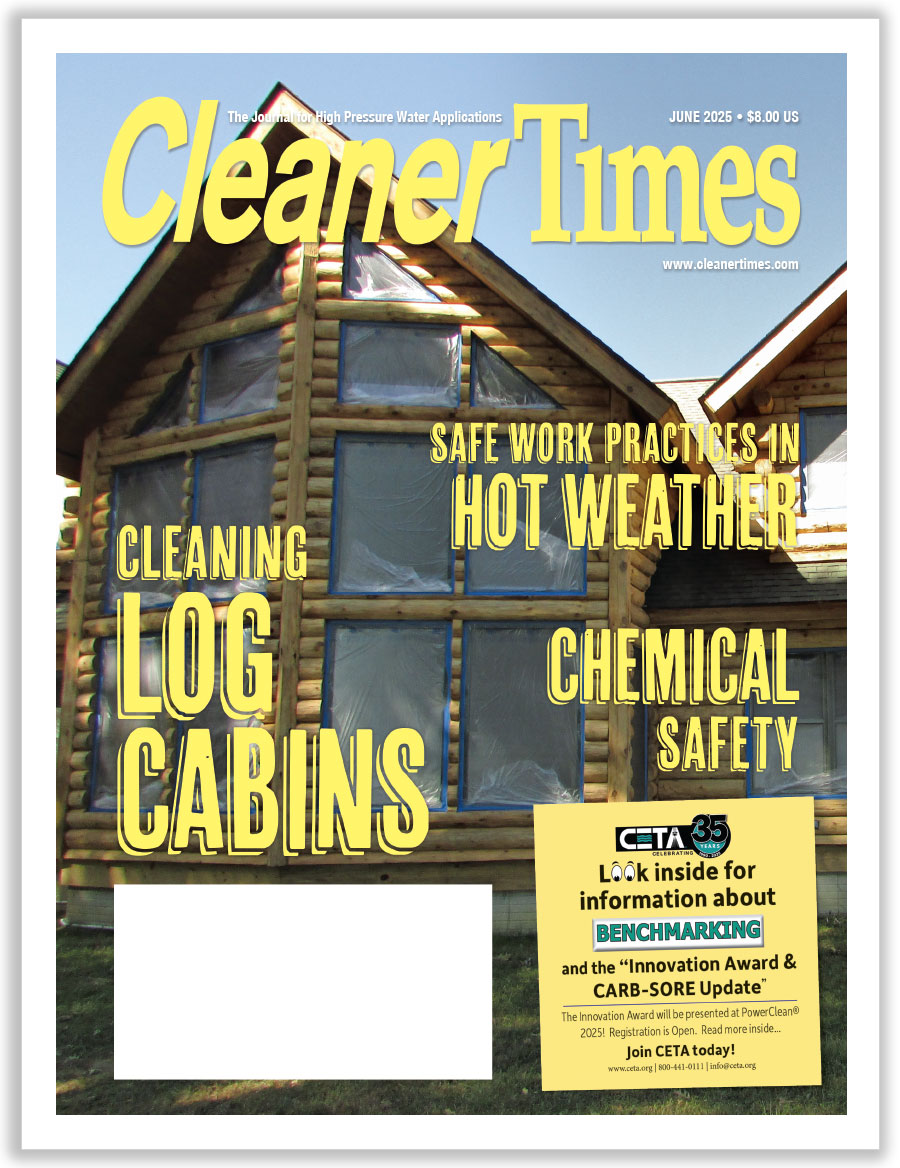
Everyone Has Responsibility
By Diane M. Calabrese / Published May 2019

P
roper Protection
Primary responsibility? Forget the qualifier. When the issue is proper protection for operating equipment or working on a jobsite of any kind, there is responsibility alone. And everyone has it.
There is a question that should always be asked when the subject is proper protection, says Deanne Case, TurtleSkin sales representative with Warwick Mills Inc. in New Ipswich, NH: “How can the worker advocate for his or her own personal protection?”
Case answers the question for us. “The protection of the waterjet operators starts with the operators themselves,” she explains. “The operators should be aware of the risks involved in their job and what measures can be taken to ensure their personal safety.
“The operators need to advocate for themselves if they feel that their working environment poses a threat and if the proper PPE is not provided in order to complete their job safely,” continues Case. “That being said, companies must adhere to best practices and zero tolerance standards for personal protection in the workplace and have the following in place to ensure their employees’ protection: safety and operating procedures, proper training, use and availability of PPE, and enforcement of a safety plan.”
The zero-tolerance dimension of worker safety merits serious consideration. As such, Case shares an excerpt from a letter written by Jenny Houston, executive vice president at her company. [See sidebar on page 35.]
The manufacturer, distributor, and end user of equipment and ancillaries are all part of the equation that adds up to proper protection and a safe work environment. Those who operate equipment have multiple concerns at any given moment—their environs, optimal performance of machines and ancillaries, etc. They welcome help from their industry partners.
Companies that manufacture protective clothing play a highly visible and extremely important role in disseminating information about proper protection. So do the manufacturers of equipment who have safety in mind with every improvement and innovation they make.
Still, do not overlook the role of the distributor. A link between manufacturer and end user, the distributor keeps information flowing in both directions.
Partnering to Help
Whether the setting is a contractor’s jobsite or the floor of a manufacturing plant, proper protection, which is PPE that matches the conditions encountered, is a must. OSHA (Occupational Safety and Health Administration) standards establish expectations, and employers use their experience, consultants, and best practices in their industry to ascertain they meet them.
Best practices are never static. It’s the communication and commitment to rigor among industry members that informs practices and leads to modifications as necessary.
Keeping pace with new products and changes in best practices is a challenge. Having a reliable partner who can offer guidance helps.
“As a distributor, I do my best to provide as much safety info as I can about the products we sell,” says Tracy Handl, COO at North American Pressure Wash Outlet in Gainesville, GA. “For chemicals, an SDS sheet will provide information about the product’s safety concerns as well as protective equipment recommended. Those are always available from us and provide good info about the cleaners/chemicals being handled.”
Distributors can help end users find answers. “There are many places to get information about the items in use by a company, and I think there is some responsibility of the company to train employees in the proper use and handling of items they work with,” says Handl. “Distributors should be a great place to get information if someone is unsure because we are a liaison between the manufacturer and the end user. Even if we do not know, usually a short phone call can get the answer.”
It’s difficult to gauge whether it is surprising that there are still equipment end users who ignore advice about proper protection. We have all walked past worksites and seen things such as an individual with no safety glasses using a jackhammer. It may not be common, but each instance is alarming.
“We get to hear stories often of accidents or harm that has happened to someone who did not wear personal protective equipment,” says Handl. “Wearing sandals or crocs when washing, having the safety glasses on top of their head… shorts or no sleeves when working with hot water—all these things can have very bad consequences.”
Anything can happen. Be prepared.
“I think it is important to have rules and regulations in place for employees to aid in safe operations,” says Handl. “Dress codes should be laid out right from the start. Training and holding people responsible in a company setting is paramount for the safety of everyone who may be on a jobsite.”
The unpredictability of the many ways in which injuries can occur on a jobsite is known best by those who have been injured in any way. “I personally got a papercut on my eye while packing a box,” says Handl. “Who would think they needed safety glasses packing a box? That just shows that accidents can happen anywhere and very quickly, so safety has to be thought about in every situation, at all times.”
Handl does not just talk with customers of his business. He is also engaged in safety education through a professional organization.
“I teach a basics course for PWNA, and we talk about safe operations a lot during the class,” explains Handl. “Our industry is doing more training than ever before. Organi-zations, distributors, and manufacturers are all aiding in getting the word spread. Getting to any event or training that can be taken will increase knowledge that may actually prevent a bad accident.”
Every Single Time
Anyone who even for a moment entertains a just-this-once thought should banish the notion permanently. Consistency in following best practices is the only way to ensure no lapse in proper protection.
As an incentive for consistency, remember the correlated issues that follow from an incident. There is the human toll of an injured worker or workers. There is also the financial toll—possibly a ruinous one.
“What is the cost of not taking worker protection seriously?” asks Handl. “Everyone will have to answer that for themselves, but I would say the cost can be everything.”
The Occupational Safety and Health Act of 1970 puts the onus on employers: Employers are responsible for providing a safe and healthful workplace for their employees.
Consequently, a business is at risk when it has employees—even one employee—who willfully flaunts his or her disregard for rules on proper protection. (Yes, it happens.) Good hiring practices and solid training ensure employees carry on as expected. Rights of workers prescribed by OSHA are covered in a related article in the June issue—see “Work Safety Guidelines”.)
OSHA issues strict rules regarding payment for PPE. It has done so since May 15, 2008, when a new rule on employer payment went into effect. For the most part, if PPE is required to meet an OSHA standard, the employer must pay for it. (See www.osha.gov/dte/outreach/intro_osha/7_employee_ppe.pdf.)
Among the obligations assigned to an employer by OSHA are hazard assessments of the workplace, determination and provision of proper PPE, training employees in use and care of PPE, maintaining PPE, and periodic review of PPE program.
The worker also has obligations. Employees are to wear PPE and do so correctly, attend training sessions on PPE, care for—clean and maintain—PPE, and inform a manager or owner if the PPE needs repair or replacement.
There may be employees who want to provide their own PPE. That’s acceptable, but the employer must make certain the protection meets required standards and matches the hazards of the workplace.
Exceptions to when an employer must pay for PPE include long-sleeve shirts, long pants, and normal work boots that would be required on a power washing jobsite but which would also double as everyday clothes. And if a worker intentionally damages or loses employer-provided PPE, the employee will be expected to replace it.
Some of the requirements about who must pay can be ambiguous. If an employee requires prescription lenses in eye protection, for example, the employer may not have to pay.
Ultimately, the OSHA rules on proper protection illustrate the shared responsibility of employers and employees and everyone involved in the industry sector.
Thoughts on Zero Tolerance
“Accidents are the result of a failure in more than one part of the overall safety system. Zero tolerance practice has been shown to reduce total costs and improve employee retention. We recognize that a zero tolerance requires planning and a proactive approach. The good news is waterjetting is a much more professional activity, and today’s professionals can write and execute good safety plans. Simply recommending the use of PPE would seem to be a very small and useful part of a zero-tolerance safety program. It is the combination of PPE, safety and operating procedures, and enforcement that all combine to provide a safe environment for waterjet operators.”
—Jenny Houston from Letter to George Savanick in response to David M. Schriever’s email (of Safety Manager Premier Manufacturing Support Services, Inc.) responding to our [Warwick Mills] proposed change to the WJTA Recommended Practice





